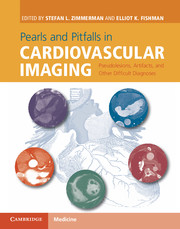 Pearls and Pitfalls in Cardiovascular Imaging
Pearls and Pitfalls in Cardiovascular Imaging from Section 11 - Veins
Published online by Cambridge University Press: 05 June 2015
Imaging description
Varicose veins may be seen as round or oval soft tissue density masses on CT, particularly when they are seen on a plane perpendicular to its course. Typically, varicose veins are easily diagnosed with intravenous contrast material, which helps to detect the continuity between varicose veins and other venous structures, and to determine the true vascular nature of the varicose veins. However, when contrast is not administered or enhancement of the vein is poor due to early arterial phase or thrombosis, it may be confused with lymphadenopathy or another mass (Figure 91.1).
Reformatted coronal or sagittal images along the course of the dilated vein will help to differentiate dilated veins from other pathologies. In patients with venous obstruction, knowledge of collateral pathways in chest, abdomen, and pelvis is essential to avoid misinterpretation.
Importance
Varicose veins are commonly encountered at cross-sectional imaging of the thorax and abdomen. These vessels can be mistaken for adenopathy, which could lead to improper staging of patients with cancer or unnecessary work-up for malignancy. Erroneous biopsy of varicose veins may lead to profound hemorrhage.
Typical clinical scenario
Varicose veins are enlarged and tortuous venous channels, which are commonly caused by retrograde flow due to incompetency of valves or obstruction to flow. Obstruction of the venous flow may be secondary to thrombus, external compression, or congenital.
In patients with occlusion of the superior vena cava and its tributaries, the collateral venous pathways are often categorized into four main pathways: lateral thoracic, internal mammary, azygos, and vertebral pathways (Figure 91.2). In the abdomen, internal mammary pathways form anastomoses with the superficial epigastric veins, which may be seen in the anterior abdominal wall of patients with superior vena cava obstruction (Figure 91.3). When the inferior vena cava is obstructed, the ascending lumbar vein, which drains into the azygos-hemiazygos system, may be dilated. Dilated azygos or hemiazygos veins can be confused with retroperitoneal, retrocrural, or paraspinal mass or adenopathy (Figure 91.4). In patients with portal hypertension, varicose veins may form in the esophagus or upper abdomen, and may simulate a mass or adenopathy (Figures 91.1 and 91.5).
To save this book to your Kindle, first ensure [email protected] is added to your Approved Personal Document E-mail List under your Personal Document Settings on the Manage Your Content and Devices page of your Amazon account. Then enter the ‘name’ part of your Kindle email address below. Find out more about saving to your Kindle.
Note you can select to save to either the @free.kindle.com or @kindle.com variations. ‘@free.kindle.com’ emails are free but can only be saved to your device when it is connected to wi-fi. ‘@kindle.com’ emails can be delivered even when you are not connected to wi-fi, but note that service fees apply.
Find out more about the Kindle Personal Document Service.
To save content items to your account, please confirm that you agree to abide by our usage policies. If this is the first time you use this feature, you will be asked to authorise Cambridge Core to connect with your account. Find out more about saving content to Dropbox.
To save content items to your account, please confirm that you agree to abide by our usage policies. If this is the first time you use this feature, you will be asked to authorise Cambridge Core to connect with your account. Find out more about saving content to Google Drive.